Tarantula biology
| Tarantula naming |
Biology in general | They differences and variety |
|
|
Size |
Vogelspinne (germ.), Mygale (fr.), Bird-Eater, Bird-Spider , Tarantula, Baboon-Spider, Monkey-Spider (eng.), Hierba (weed, mex.), Mata-Caballo (murderer of horses, mex.) etc. – here is by far not full list of names, which calling tarantulas by different folk of world.
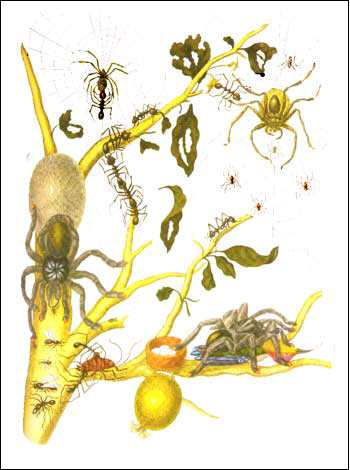 As a whole the name «tarantulas=bird-eating spiders» was given due to several old-time engravings, first from which was drawn by german biologist - animalist Maria Sibilla Merian and was public on results of her investigations in Surinam (1699 - 1701) in the work “Metamorphosis insectorum Surinamensium” (1705), where she observed the large spider (Avicularia avicularia) has hit upon hummingbird in nest (right picture).
As a whole the name «tarantulas=bird-eating spiders» was given due to several old-time engravings, first from which was drawn by german biologist - animalist Maria Sibilla Merian and was public on results of her investigations in Surinam (1699 - 1701) in the work “Metamorphosis insectorum Surinamensium” (1705), where she observed the large spider (Avicularia avicularia) has hit upon hummingbird in nest (right picture).
The same fact was shown on engraving of other researcher - Mr. Beits.
This observation also was confirmed by findings of researcher A. Everett concerning the tarantula species of genus Phormingochilus in Kuala-Lama (North Calimantan), described lately as P. tigrinus, collected in a small bird`s nest being feeding on nestling.
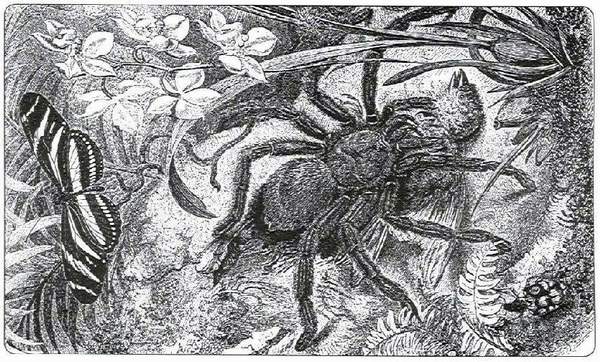 In all times spiders, but more so tarantulas, a creatures, personifying for many people to nightmares and causing superstitious terror (not accidentally name "arachnophobia" carries in psychiatries of one of phobias of people).
In all times spiders, but more so tarantulas, a creatures, personifying for many people to nightmares and causing superstitious terror (not accidentally name "arachnophobia" carries in psychiatries of one of phobias of people).
Their accuse of different sort villainy (murder of domestic animales), about they wrote legends, myths, makes horror movie, their use in food aborigines of Asia and America and at present times…
In general, mankind never avoid tarantulas by side, often on purpose cruelly destroy whole populations, useing pesticides, cauterizing, ploughing lands which they lives, considering their terribly poisonous, though to date not a single fatal accident as a result of bite is registered.
Local struggle of local fermers with mexican red-knee tarantula Brachypelma smithi has brought about nearly full destruction of its population in nature.
Only last two-three decades in connection with popularization of keeping tarantulas between collectors, began study these ancient, not submitting for the most deal of some serious danger, enigmatic and, certainly, beautiful creatures.
It is interesting that whole known information on biologie of tarantulas gets in the results of study, as a rule, spiders, which were kept in captivity, and only small its part – on observations right in places their inhabits.
Thereby, each amateur keeping tarantulas in home, has beautiful possibility to became witness and discover a new particularities of physiology or biologies of these while obviously not enough studied representatives of World fauna.
As was it already mentionned earlier, tarantulas inhabits different lands of the Eath - from 40° north to 40° south of equator. On all length of area of spreading the species of Theraphosida family, they inhabits literally all possible natural landscapes – from semi-desrts and desert to moist equatorial forests, with the exclusion of swamps, flood meadows and pure sands.
 |
 |
They meet both on mainlands and on different large and small islands of all continents of Globe, except Antarctica. But, certainly, dominating amount of species of tarantulas inhabits the humid tropical forests of America, Asia and Africa.
In general, all tarantulas outwardly have enough typical look. From other spiders their, either as rest representatives of mygalomorph spiders (Mygalomorpha), possible distinguish on:
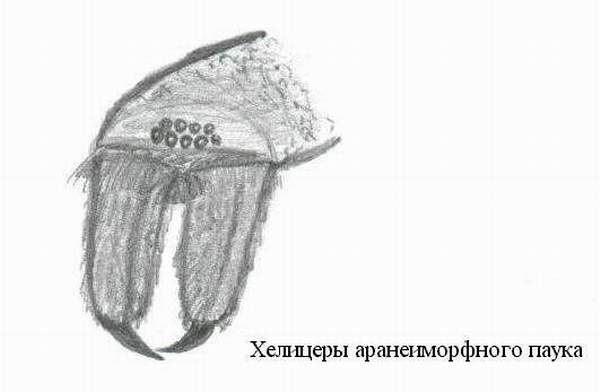 |
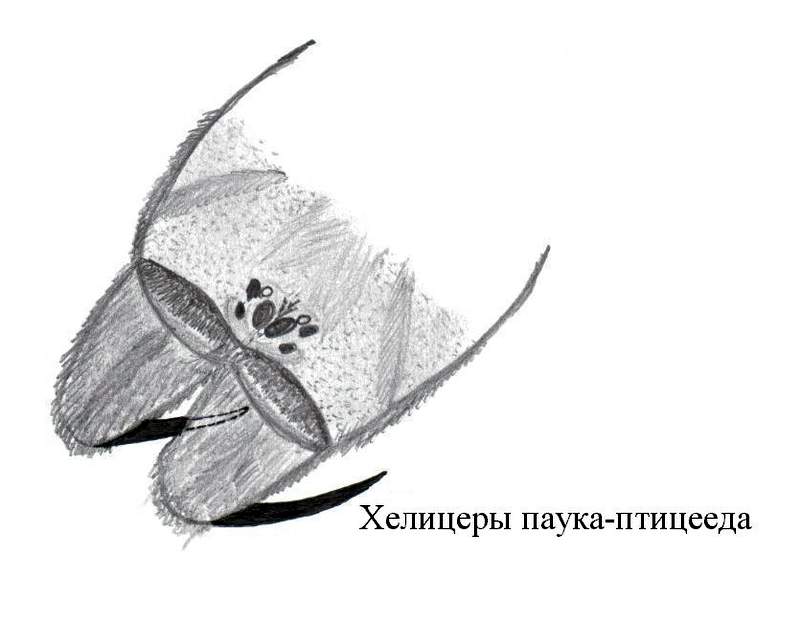 |
- presence of two pairs lungs,
- chelicerae directed onward and downwards,
- last segment of chelicerae (fang), which is in calm condition is embedded in lower part of main segment and is brought forth vertically onward among mygalomorph tarantulas, but in araneimorphs - in its internal part and is brought forth outside and inside.
Herewith visible difference from representatives of related family Barychelidae, with which often even systematists mixed tarantulas, is expressed in vastly longer silken apurtenances, which beside tarantulas are noticeably abbreviated.
Differences amongst tarantulas themselves, basically, are determined with their lifestyle. So, arboreal tarantulas have more lengthened body and legs, which of what they more movable (species of southamerican genus Tapinauchenius capable much rapidly move and run away from terrarium in most slightest slots, such a speedy beasts is african Stromatopelminae). Terrestrial tarantulas - more robust massive, their thorax usually are broader, limbs shorter. They more slow, though many species are capable enough to quickly move. Hind legs of some digging species are curved (african Hysterocrates spp., Citharischius spp., Eucratoscelus spp.).
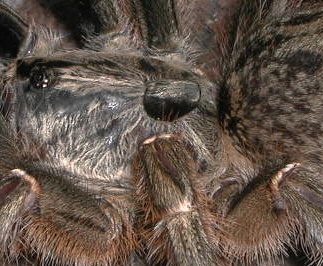 On central part of the thorax, at the fovea of african species of Ceratogyrus and also costarican Sphaerobothria hoffmanni there is a horn-like projection, importance of which while remains riddle for scientists (supposedly used to store the nutrients). There is a resemblance of similar projection beside several species of american tarantulas of genus Cyrtopholis (C. bryantae, for example).
On central part of the thorax, at the fovea of african species of Ceratogyrus and also costarican Sphaerobothria hoffmanni there is a horn-like projection, importance of which while remains riddle for scientists (supposedly used to store the nutrients). There is a resemblance of similar projection beside several species of american tarantulas of genus Cyrtopholis (C. bryantae, for example).
Tarantulas have interesting defence mechanisms against enemies. Although these mechanisms are similar they differ from species to species and are dependent on physiology.
All tarantulas are covered with hair. These setae or hairs perform different functions depending on location. Practically all species of New World tarantulas (those of the American continent and islands) have thousands of "urticating" hairs located on the opisthosoma. These include but are not limited to the subfamilies Aviculariinae, Ischnocolinae and Theraphosinae. Most of New World tarantulas have urticating hairs except of the genus Psalmopoeus and Tapinauchenius (are absent). In the species Ephebopus a patch of urticating hairs is found on the apical end (upper, inner top) of the palp femur (Rick West, personal communication).
Urticating hairs are an efficient protection against attack. When threatened the tarantula flicks hairs using either one or both of it's hind legs rubbed against the opisthosoma.
Urticating hairs do not appear at birth but form with each consecutive molt, outwardly presenting itself round area of more dark hairs on upper back part of abdomen of juvenil, widening from molt to molt, but in elder ages - merging with main tone of abdomen colouration.
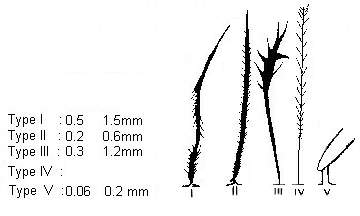 There are six different types of urticating hair known (M. Overton, 2002). As seen in the illustration they are all different in shape and size.
There are six different types of urticating hair known (M. Overton, 2002). As seen in the illustration they are all different in shape and size.
It is interesting to note that urticating hairs are absolutely absent in Old World (Asian & African) tarantulas.
Only tarantulas from genera Avicularia, Pachistopelma и Iridopelma have urticating hair of type II. Type II urticating hair is not kicked off by the tarantula. Instead direct contact is necessary much like with thorns or cactus, Toni Hoover, 1997).
Type V urticating hair is typical of the species of genera Ephebopus. As mentioned earlier is located on the pedipalps. They are much shorter and lighter in contrast with other types of urticating hair. These are easily thrown by the spider into the air (Marshal and Uetz, 1990).
Type VI urticating hair is found in the genera Hemirrhagus (Hemirrhagus (F. Perez-Miles, 1998).
Types I, II, III and IV urticating hairs can be found in the subfamilies Avicularinae and Theraphosinae.
According to Vellard (1936) и Buecherl (1951), generas with the most urticating hairs are Lasiodora, Grammostola and Acanthoscurria. Excluded Grammostola (has types III and IV), representitives of Lasiodora and Acanthoscurria have type I и III urticating hairs.
Type III urticating hair is typically found on the species of Theraphosa spp., Nhandu spp., Megaphoboema spp., Sericopelma spp., Eupalaestrus spp., Proshapalopus spp., Brachypelma spp., Cyrtopholis spp., Iracema spp. and other genera of subfamily Theraphosinae (Rick West, 2002).
Type III urticating hair are most efficient for defence against vertebrates and invertebrates. These hairs present dangerous implications to humans as well.
The latest studies suggest urticating hairs from tarantulas present not just a mechanical but a chemical influence on the skin and mucous membranes. This would explain the different reactions of people to urticating hairs (Rick West, 2002). It seems likely the hairs cause an accumulative reaction in people.
Tarantulas without urticating hairs have other means of defence. Their first line defence is an aggressive stance with the front legs in the air, body weight on the hind legs. The cheliceras (fangs) bared. This stance is followed by an attack. Tarantulas Stromatopelma griseipes, Citharischius crawshayi, Pterinochilus murinus and Ornithoctoninae spp. are examples of Old World tarantulas that use this defence.
Such behaviour is not typical of New World tarantulas. Old World tarantulas are more aggressive and their venom is more toxic than New World tarantulas.
New World tarantulas will at the moment of danger, turn toward the attacker and briskly rub their hind legs against the opisthosoma throwing the urticating hairs in the direction of the enemy. The cloud of small hairs will get into the mucous membrane of small mammals and cause oedema, difficulty in breathing which can be fatal. In humans this cloud of urticating hairs can cause allergic skin reactions which can manifest itself as inflammation, rash and itching. The reactions can last for several hours or days. A solution of 2-2,5% hydrocortisone cream applied to the affected area may help relieve the symptoms.
A more serious consequence is urticating hair in the eyes. In this case it is necessary to immediately wash the eye thoroughly with copious amounts of cold water and see an ophthalmologist.
Urticating hair is not just thrown at an enemy as a first line defence. It is also used as an indication of territory. It can be found on and around the burrow entrance and in webbing for protection (for example, some of Theraphosinae subfamily species include these hairs in cocoon silk).
Some species, beside urticating hairs, also have hard spins on hind legs (Megaphobema robustum), actively use them at defence: spider, by turning around, can hit them the enemy. The tarantula's most powerful weapon is its chelicera (fangs). The chelicera are capable of inflicting a very painful bite. Normally the spider's chelicera are closed and folded back. 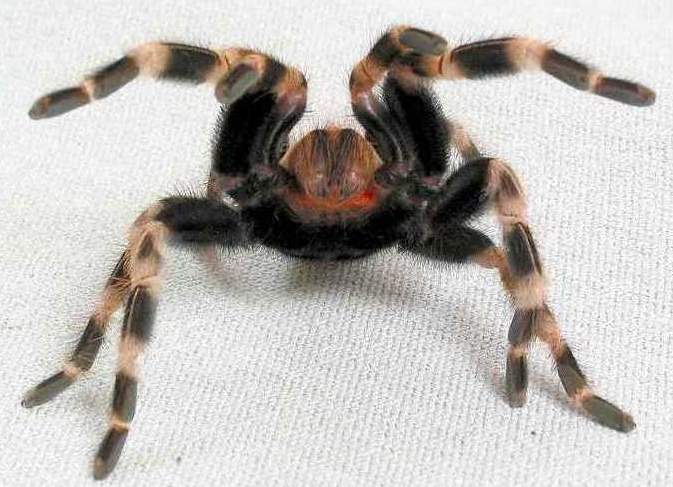 When the tarantula is excited or manifesting aggression it raises the front part of it's body and front legs. The chelicera are opened and forward in preparation to attack. Many species literally fall on to their back during this exhibition. Others rush forward emitting a hissing sound.
When the tarantula is excited or manifesting aggression it raises the front part of it's body and front legs. The chelicera are opened and forward in preparation to attack. Many species literally fall on to their back during this exhibition. Others rush forward emitting a hissing sound.
Species of Anoploscelus lesserti, Phlogius crassipes, Citharischius crawshayi, Theraphosa blondi, Pterinochilus spp. and others are capable of "stridulation" (hissing) sounds. These sounds are created by «stridulating apparatus», пwhich are groups of hairs disposed on bases of the chelicera and coxa, and trochanter of the pedipalps, and forelegs. The sound is caused by rubbing.
Generally, tarantula bites are no more serious than the sting of a bee or wasp. Often the bite is a "dry bite" in which no venom is released. Tarantula venom is neurothoxic, and serious effects are uncommon. Aggressive Asiatic and African tarantulas have a more toxic venom particularly those of the genera Poecilotheria, Pterinochilus, Haplopelma, Heteroscodra, Stromatopelma, Phlogius) and Selenocosmia. The effects of a "hot venom" would be local numbness and inflammation, an increase in body temperature, weakness, and headache. In such cases a doctor should be consulted.
Likely, consequences pass from one to three days after the bite. Occasionally ill effects such as sensations, loss of sensitivity, and weakness (teak) at the bite site may last for several days. Bites inflicted by genera Poecilotheria can cause muscle spasms for several weeks (author's experience).
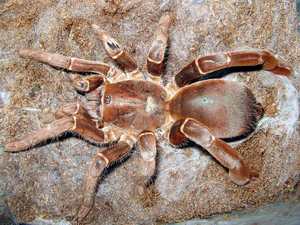 As for the tarantula «stridulating apparatus» have to say that in spite of that it is morphologic and taxonomic feature behavioural context of «stridulation» hardly studied. The stridulating bristles of the Anoploscelus lesserti and Citharischius crawshayi are located on the coxa and trochanter of first and second pair of legs. During stridulating both types raise the prosoma slightly. Friction is caused by the chelicera and first pair of legs. The pedipalps and first pair of legs are thrown at the enemy. The Pterinochilus spp. has stridulating hairs on the external part of the chelicera. The sound is made by rubbing the pedipalp's stidulating hair against those of the chelicera.
As for the tarantula «stridulating apparatus» have to say that in spite of that it is morphologic and taxonomic feature behavioural context of «stridulation» hardly studied. The stridulating bristles of the Anoploscelus lesserti and Citharischius crawshayi are located on the coxa and trochanter of first and second pair of legs. During stridulating both types raise the prosoma slightly. Friction is caused by the chelicera and first pair of legs. The pedipalps and first pair of legs are thrown at the enemy. The Pterinochilus spp. has stridulating hairs on the external part of the chelicera. The sound is made by rubbing the pedipalp's stidulating hair against those of the chelicera.
The length and frequency of stridulation depends on the species. Anoploscelus lesserti and Pterinochilus murinus сforms 95-415 MC, the frequency reaches 21 kHz. Citharischius crawshayi produces the sounds at 1200 mc at a frequency of 174 kHz. A tarantula sound sonogram shows individual aspectual features of species. Such defensive behaviour probably serves as an indication that the individual burrow is occupied. It also may be a method of protection from small mammals and ravenous hawk-wasps.
There are other ways a tarantula may protect itself as noted by many amateurs in the field. Note the some representatives of the genus Hysterocrates and Psalmopoeus cambridgei take to the cover of water when threatened. Soren Rafn has observed tarantulas staying in this condition for several hours with only their knee or the tip of the opisthosoma exposed (personal communication). This is possible because of the tarantula's hairs form an air bubble around the spider. The exposed part allows a supply of fresh air for breathing.
Also many keepers notice that tarantulas of genus Avicularia being anxious «shoot» the enemy with the droppings. However this fact at present absolutely not studied and in literature is not described. In conclusion I will say at present defensive behaviour of tarantulas has not been well studied. I certainly feel that we as keepers and breeders of captive tarantulas are best suited to observe and record many new and interesting facts of tarantula behaviour.
In general all tarantulas anyway, at present times, looks like its prehistorical ancestor. But if Megrachne servinei (but see notes here) was supposed to reach 50 centimetres in legspan (according to some researches – 90 cm), maximum size of its contemporaries on information from different sources inheres within 28-30 cm.
The record brought in Guiness Record Book belongs to Goliaph tarantula Theraphosa blondi, from Venezuela (1999, 28 сm in legspan). With him contended the other goliaph-tarantula - pinkfooted Theraphosa apophysis. List of pretenders on crown ends the brazilian salmon pink tarantula Lasiodora parahybana.
These three species are far from exhausted giants amongst tarantulas. On information, enterring from zoocompanies-exporters, known following tarantulas greatly large sizes:
- Bolivian blue leg Pamphobeteus antinous – 24 сm;
- Giant pink brazilian Vitalius roseus – 24 сm;
- Brazilian pink Pamphobeteus sp. "platyomma" – 22,5 сm;
- Colombian giant Megaphobema robustum – 22,5 сm;
- Ornamental tarantulas of genus Poecilotheria spp. (P. rufilata, P. ornata, P. subfusca) – 22,5-24 сm;
- African baboon-tarantulas of genera Hysterocrates (H. sp "hercules", H. didymus, H. scepticus) – 25 сm;
- southamericans of genus Acanthoscurria (A. sternalis, A. atrox) – 21-22,5 сm;
- Colombian giant black Xenesthis monstrosa – 22,5 сm.
Presented above list is far from packed (look species describtion).
Sizes of most small tarantulas of fauna of the World hardly reach 2-2.5 cm in legspan, and the smallest known tarantula was considered Acanthopelma annae from Belize, which reaches 2 cm (now is removed under the Barychelidae subfamily).
Most tarantulas lives in burrows, which they usually dig. Also they occupy a small mammals and reptiles burrows. The typical burrow of spider presents itself simple tube finishing with "dwelling camera", which is inside plaited by web. Only small quantity of species (Ischnocolus spp.) aside from main tube dig lateral tubes also finishing with "dwelling cameras".
Often entry in burrow is plaited with web (Citharischius crawshayi, Coremiocnemis spp., Ephebopus spp., Haplopelma spp.) containing vegetable remains, earth or sand, that prevents the hit inside water and prevents the burrow from flooding. Also arboreal species web in they silken arboreal retreats sheets of trees, pieces of bark or wood, and sometimes «urticating hairs», in addition preventing its retreats from possible enemy invasion.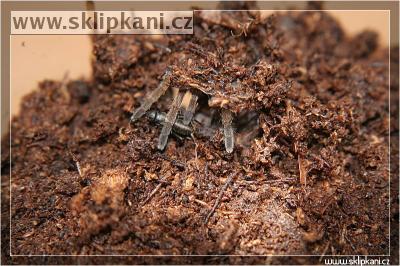
The small theraphosids from Africa region - Idiothele sp. are recently start to known as the only tarantulas living in burrows constructing the "doors" at the entrence - the same way like it is well-known for famous south asian Liphistius spp. (Liphistiidae) and different species of Ctenizidae and Pachylomeridae (Bothriocyrtum californicum, Cyclocosmia torreya, Ummidia sp.), Migidae, Cyrtaucheniidae, Idiopidae, Nemesiidae families.
Exclusive majority of terrestrials and burrowers leads independent, single lifestyle, but concerning the species of genus Hysterocrates (from Sao-Tome Island, by Peter Mirukashi) and Pamphobeteus sp. (from Tambapata, Peru, by Martin Nickolas) there are information available about the facts that several adult spiders as well as spiders of the different ages share simultaneously the same burrows.
Tarantulas, which is obligate predators, do not tolerate proximities in their burrow some other animals, so interesting fact about two species of American tarantulas – Aphonopelma sp., known from southwest of USA, which is share its burrow with a small frog Gastrophryne olivacea (Hunt 1980, Breene 1996), and southamerican tarantula Pamphobeteus sp., which was mistakenly identified as Xenesthis immanis, also a small frog - Chiasmocleis ventrimaculata (Cocroft and Hambler, 1989). Exact explanation of this facts for this day is not found, but it is expected (Breene 1996), that such symbiosis, profitable as to spiders itself, so and to amphibious. Because frogs gets under protection of powerful tarantula chelicerae and so tarantulas - they are saved from enxiety on the part of small insects, and in the first place – ants, which cause it significant enxiety, particularly females at period of care of cocoon.
Also, once in a while noticed, so-called, colonial inhabiting of tarantulas, when quite a number of burrows is disposed in direct vicinity each other. So, known fact of such occupying by species Aphonopelma anax grass lawns in south Texas, USA (Breene 1996). The same information known about Pamphobeteus nigricolor and some other tarantulas.
An interesting fact noted that some species of terrestrial tarantulas lead rambling lifestyle, not having constant refuge (unlike most other theraphosid species, inhabitting, as a rule, same burrow during whole life). They actively move in hunting for food at night time, and at daytime hides in different natural covertures or occupy temporarily empty burrows (Grammostola sp. from Chile, Phormictopus spp., Cyriocosmus ritae, as well as even such large species as Lasiodora parahybana).
Finally, some tropical tarantulas is presented by species leading arboreal lifestyl. This is representatives of south-american subfamily Avicularinae (genus Avicularia, Tapinauchenius, Iridopelma, Pachistopelma), and also tarantulas of genus Psalmopoeus (of asian subfamily Selenocosmiinae).
Africa is presented by other subfamily of arboreals – Stromatopelminae (species of genus Heteroscodra, Stromatopelma and Encyocratela). Asiatic fauna of arboreal tarantulas includes all species of genus Poecilotheria (subfamily Poecilotheriinae) and Phormingochilus (subfamily Ornithoctoninae).
All species leading arboreal lifestyle live in entwined them special silken retreats (Avicularia spp., Psalmopoeus spp., Poecilotheria spp.) in hollows of trees, under bark, between epiphit plants etc.
Arboreal tarantulas are the only tarantulas (with the exception of the above mentioned and the small african tarantula Holothele incei), which are well-know living in groups in the same retreat, and thus, provided with the proper environment, can be kept together in one terrarium. Well known for the matter of that following tarantulas: Avicularia avicularia, Avicularia minatrix, Poecilotheria subfusca, Poecilotheria regalis. However, in my opinion, communal keeping of even mentioned species, anyway connected with the risk of loss as a result of cannibalism.
All tarantulas lead twilight-night lifestyle, but at breeding period reaching maturity adult males actively move in quest of females at day time. Also in dull weather once in a while possible to observe the tarantula exposed its front part of thorax and legs from burrowin in expectation of catching the prey, but, however, rapidly escapes bach the burrow under most slightest appearance of dangers (sharp change to intensities of illumination, vibrations of air or ground etc.).
All species of tarantulas are a predators. Their ration is extremely varied and consists, mainly, of different insects, small mammals, amphibious and lizards. Also knowned events of eating them nestlings and small snakes. Follows to take into account that tarantulas inherent cannibalism, missing only beside spiderlings certain time after hatchling from cocoon, and under event, they willingly eat its congener of smaller size.
Prey usually is killed with poison. The poisonous ferrics of tarantulas are small and wholly fits in chelicerae. Each of paired ferrics is encircled with spiral musculature, which reduction of provide entering of the poison in body of victim through hole at the end of chelicerae apical spin-like segment. On small preys a poison acts practically instant, additionally the larger prey objects fasten spider by web to substratum and remain it before thei lost they ability to mave.
Size of food object is defined, first of all, possibility of tarantula to cope it. In some cases this can turn out to be, for instance, on some reason weakened mouse with the size of the tarantula itself, but maybe a lager size. In captivity they eat also and still food: bits of meat, dead mice and frogs.